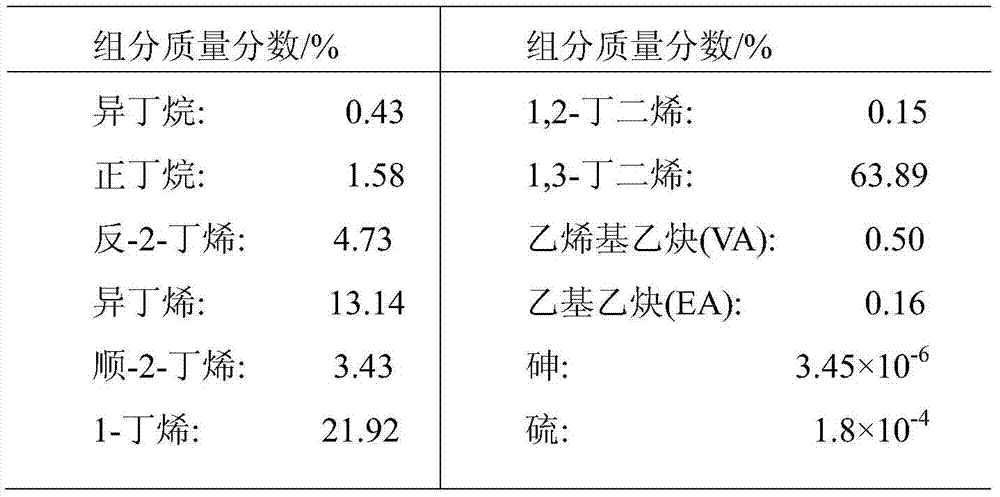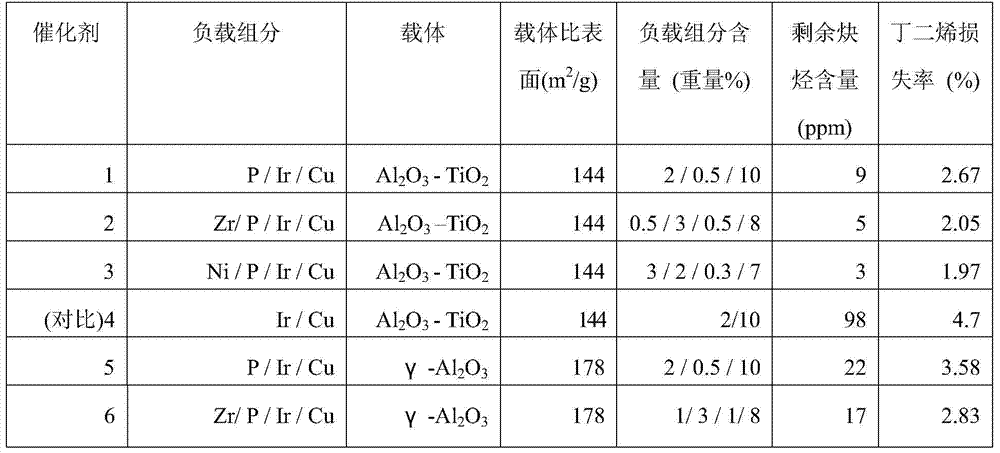A kind of preparation method of alkyne selective hydrogenation catalyst
A technology for selective hydrogenation and catalysts, applied in chemical instruments and methods, metal/metal oxide/metal hydroxide catalysts, physical/chemical process catalysts, etc. Problems such as poor hydrogen selectivity
- Summary
- Abstract
- Description
- Claims
- Application Information
AI Technical Summary
Problems solved by technology
Method used
Image
Examples
Embodiment 1
[0048] Embodiment 1—preparation of catalyst 1
[0049] Firstly, a titania-alumina composite oxide carrier was prepared according to the method in Example 1 of CN1184289C. Take the specific surface area as 160m 2 / g, 90g of clover-shaped alumina with a pore volume of 0.58mL / g and a most probable pore diameter of 130 angstroms, impregnated with 0.557g / mL dilute sulfuric acid solution of 63 ml of titanium sulfate, stirred for 15 minutes, and dried at 120°C for 8 hours Then, it was calcined at 900° C. for 4 hours to obtain a titanium oxide-alumina composite oxide (A-1). The obtained composite oxide had a titanium oxide content of 10% by weight and a specific surface area of 144m 2 / g, the pore volume is 0.56mL / g, and the most probable pore diameter is 125 angstroms.
[0050] Prepare 63mL of a mixed aqueous solution containing copper nitrate, ammonium phosphate, and iridium trichloride as the immersion solution. In the immersion solution, the amount of copper nitrate is 10% by...
Embodiment 2
[0051] Embodiment 2—preparation of catalyst 2
[0052] Prepare 63mL of a mixed aqueous solution containing copper nitrate, iridium trichloride, ammonium phosphate, and zirconium nitrate as the impregnating liquid. In the impregnating liquid, the amount of copper nitrate is 8% by weight calculated as copper element, and the amount of iridium trichloride is calculated as iridium element The amount of ammonium phosphate was 0.5% by weight, the amount of ammonium phosphate was 3% by weight as phosphorus element, and the amount of zirconium nitrate was 0.5% by weight as zirconium element. At room temperature, take 100g of titanium oxide-alumina composite oxide (A-1), impregnate it with the previously prepared impregnation solution, dry it at 120°C for 4 hours, then calcinate it at 500°C for 4 hours, take it out and cool it to room temperature . The catalyst prepared in this way is designated Catalyst 2.
Embodiment 3
[0053] Embodiment 3—preparation of catalyst 3
[0054] Prepare 63mL of a mixed aqueous solution containing copper nitrate, iridium trichloride, ammonium phosphate and nickel nitrate as the immersion solution, in the immersion solution, the amount of copper nitrate is 7% by weight calculated as copper element, and the amount of iridium trichloride is calculated as iridium element The amount of ammonium phosphate was 0.3% by weight, the amount of ammonium phosphate was 2% by weight as phosphorus element, and the amount of nickel nitrate was 3% by weight as nickel element. At room temperature, take 100g of titanium oxide-alumina composite oxide (A-1), impregnate it with the previously prepared impregnation solution, dry it at 120°C for 4 hours, then calcinate it at 500°C for 4 hours, take it out and cool it to room temperature . The catalyst prepared in this way is designated Catalyst 3.
PUM
| Property | Measurement | Unit |
|---|---|---|
| specific surface area | aaaaa | aaaaa |
| pore size | aaaaa | aaaaa |
| specific surface area | aaaaa | aaaaa |
Abstract
Description
Claims
Application Information
 Login to View More
Login to View More - R&D
- Intellectual Property
- Life Sciences
- Materials
- Tech Scout
- Unparalleled Data Quality
- Higher Quality Content
- 60% Fewer Hallucinations
Browse by: Latest US Patents, China's latest patents, Technical Efficacy Thesaurus, Application Domain, Technology Topic, Popular Technical Reports.
© 2025 PatSnap. All rights reserved.Legal|Privacy policy|Modern Slavery Act Transparency Statement|Sitemap|About US| Contact US: help@patsnap.com


